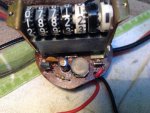Hi Carl,
I used to work on similar instruments years ago. Anything can be repaired if
its not too bad off. If nothing catastrophic has happened, these generally quit working due to a few different reasons. Usually the clock oil or lubrication thickens with age or becomes contaminated with moisture, dust, etc. Other causes could be worn pivot points or tiny brass bushings. At apparently only 700 hours that shouldn***8217;t be the cause. It takes very little to clog up the gear train. Usually a careful cleaning and proper lubing will put them back into operation. An internet search will turn up outfits that specialize in doing that. If you***8217;re careful, handy and up for the
challenge you could attempt it yourself. You wouldn***8217;t be out anything unless
you are really determined to save this at all costs and want to hire it done. Removing the bezel ring so it can be reused is the hard part. Might be hard to find a substitute for the rebuild. If you do decide to tackle it you***8217;ll want to do it in a clean environment, place it in clean pan or tub for the disassembly (there***8217;s a lot of small gears, levers, etc.), and take a lot of pictures. An ultrasonic cleaner works well for the cleaning of parts. Some watch/clock oil can be found online or at a clock repair shop. Sometimes***8230;.They***8217;re made up of sub assemblies and you can clean them without taking them apart.
The little motors rarely burn out but stop due to the same reasons as above. Some penetrating oil on the shafts will usually loosen them up again. You might be successful cleaning out the old motor lube with some alcohol, spray cleaner, etc. Let it dry completely and then re lube with proper oil. Wish you were a little closer***8230;..I***8217;d love to help you out!! Another thought....If the whole mechanism lifts out as a unit....then a careful visual inspection might
reveal the problem. The parts are delicate but you should be able to see the motor output shaft and very carefully and lightly start turning that to determine the problem. If you can separate the motor from the mechanism you could energize that and determine if it or the gear train was the problem and go from there. Good luck!! Will be fun to see all the pics!!

Since this was in a tractor I forgot to mention that vibration can cause problems with excessive wear on shaft bushings, etc.
But it could be as simple as vibration caused a motor lead to break off inside the can also. It's anybody's guess until its opened up for inspection.
Regards,
David









